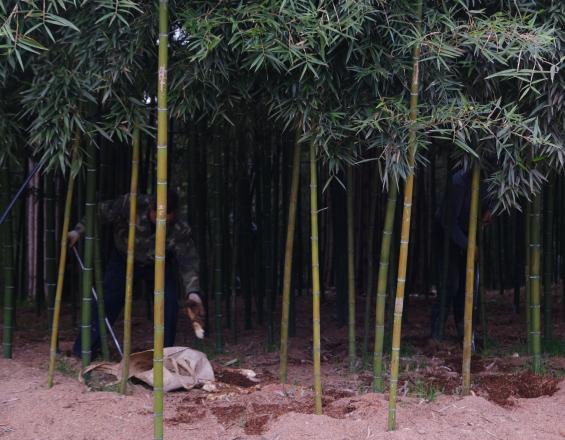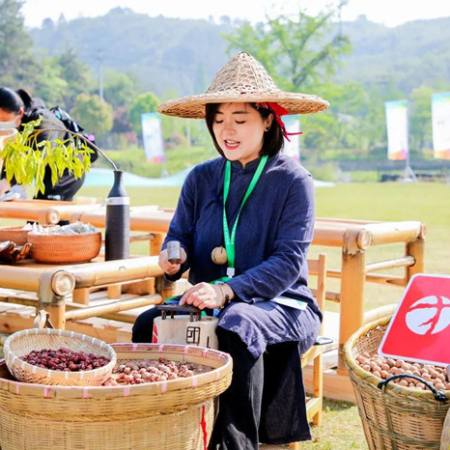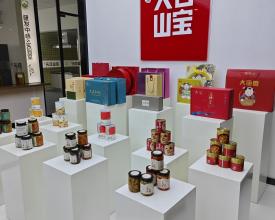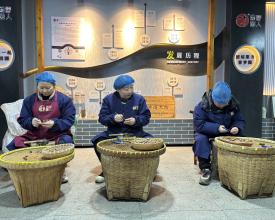
Las redes sociales aumentan el interés y los ingresos por la silvicultura sostenible en Lin'an (China)

El Bosque Modelo Lin'an, situado en el noroeste de la provincia china de Zhejiang, es rico en recursos forestales, con una cobertura forestal del 82,6% que abarca 2.618 km² de bosque. Sus especies dominantes son el bambú, el pino, el abeto chino, el nogal y el tejo chino. Lin'an, que antes dependía de la tala insostenible de madera y bambú, lo que provocaba degradación ecológica y problemas económicos, pasó a una economía forestal sostenible mediante el cultivo innovador de brotes de bambú y nogal. Este cambio propició su adhesión a la Red Internacional de Bosques Modelo (RIBM) en 1999. En la actualidad, Lin'an es conocida como la "Capital del Nogal" y la "Ciudad del Bambú" de China, así como un importante productor de brotes de bambú. Aprovechando el comercio electrónico, la marca regional y las asociaciones comunitarias, Lin'an ha mejorado el valor del producto, ha dado poder a los agricultores y ha sido pionera en un enfoque innovador que integra la protección ecológica con el crecimiento económico.
Contexto
Défis à relever
Reducir la presión ecológica: Promoción de productos agrícolas ecológicos para impulsar la transformación de la economía forestal, reduciendo la dependencia de la expansión de la tierra y de los insumos químicos y fomentando al mismo tiempo la producción sostenible.
Aumento del empleo y los ingresos: Ampliar el acceso al mercado y las ventas directas a través de una marca regional para mejorar la calidad de los productos y aumentar los ingresos de los agricultores.
Reducción de la brecha digital: Impartir formación en comercio electrónico a los agricultores para evitar la marginación de los agricultores tradicionales y ampliar las oportunidades de subsistencia.
Ubicación
Procesar
Resumen del proceso
Lin'an lanzó el comercio electrónico en 2007 para promover las ventas agrícolas sostenibles a través de una estrategia de "valor de marca y conexión digital". En 2019, estableció la marca pública regional "Tian Mu Shan Bao (Tesoros de las montañas Tianmu)", integrando brotes de bambú, nueces de nogal y otros productos bajo 32 submarcas con un estándar ecológico unificado, logrando una prima de producto del 30-50%. En 2024, las ventas bajo esta marca superaron los 350 millones de yuanes (49 millones de dólares), impulsando 1.000 millones de yuanes (142 millones de dólares) en ventas agrícolas y beneficiando a casi 100.000 agricultores. Para garantizar la calidad, Lin'an introdujo normas de grupo para productos clave y formó a 43.000 agricultores en agricultura digital, reduciendo el uso de fertilizantes en la producción de brotes de bambú en un 62%. El conocimiento de los datos impulsó aún más la sostenibilidad, con una tasa de recompra del 78% de los brotes de bambú secos ecológicos que animó a 4.100 agricultores a adoptar prácticas ecológicas, creando un ciclo positivo de mejora de la calidad y aumento de los ingresos.
Bloques de construcción
Marca de comercio electrónico
La marca pública regional ayuda a promocionar los singulares productos agrícolas de Lin'an a través de plataformas de comercio electrónico, crear productos de marca y aumentar el valor de los productos estableciendo normas de grupo.
Factores facilitadores
- La Oficina de Agricultura y Asuntos Rurales de Lin'an lanzó "Tian Mu Shan Bao (Placeres de las montañas Tianmu)", la marca pública regional, que revisa estrictamente las submarcas locales sostenibles, garantizando la calidad y el reconocimiento del mercado.
- El gobierno apoya el desarrollo del comercio electrónico, construye infraestructuras como mercados de brotes frescos de bambú y bases logísticas, y proporciona formación y ayuda financiera.
Lección aprendida
- Utilizar herramientas de datos de comercio electrónico para orientar los mercados y crear una marca que satisfaga la demanda de los consumidores.
- Establezca estrictas normas de calidad y sistemas de trazabilidad para generar confianza en el consumidor.
Agricultura ecológica y excavación cultural regional
Promover el cultivo orgánico y ecológico, vinculando el ecoturismo y otras industrias para realzar el valor cultural de los productos agrícolas locales.
Factores facilitadores
- Colaboración con instituciones de investigación para ofrecer formación y orientación sobre técnicas de plantación ecológica.
- Aprovechar la "economía de las celebridades" para crear productos emblemáticos, combinando productos locales como brotes de bambú, nueces de nogal y té con el ecoturismo para añadir valor cultural.
Lección aprendida
- La formación periódica mejora la concienciación y las habilidades de los agricultores para la plantación sostenible.
- Ofrecer subvenciones y recompensas para fomentar prácticas de plantación ecológicas y reducir los insumos químicos.
Participación comunitaria en el desarrollo colaborativo
Una red de asociaciones comunitarias fomentada para promover el crecimiento colectivo, con especial atención al fomento del espíritu empresarial femenino.
Factores facilitadores
- Lin'an ha desarrollado una sólida red de asociaciones, que ofrece servicios integrales de agricultura ecológica y marketing de comercio electrónico, promoviendo una cultura de colaboración que beneficia a toda la comunidad.
- La participación femenina en el procesamiento de brotes de bambú y nueces de nogal está muy arraigada en Lin'an. El auge del comercio electrónico ha permitido a muchas mujeres crear sus propias marcas, aprovechando sus habilidades y competencias personales. Con el apoyo de iniciativas gubernamentales que fomentan el espíritu empresarial femenino, un número creciente de mujeres se están convirtiendo en líderes empresariales en Lin'an, dando ejemplo a otras mujeres de sus comunidades.
Lección aprendida
- Crear mecanismos eficaces de cooperación comunitaria para fomentar la participación en modelos de agricultura sostenible y de producción y comercialización colaborativas.
- Utilizar plataformas comunitarias y de comercio electrónico para facilitar el intercambio de información, mejorando la transparencia y la eficiencia del mercado.
Impactos
Beneficio económico
La expansión del comercio electrónico ha ampliado el alcance del mercado, ha reducido los intermediarios y la creación de marcas regionales ha mejorado el valor y la competitividad de los productos.
La expansión del mercado y la creación de marcas han fortalecido la industria de los productos forestales no madereros (PFNM), han fomentado la innovación, han establecido normas y se han integrado con el turismo y la cultura.
La racionalización de las cadenas de suministro, la adaptación a la demanda del mercado, el aumento de la producción ecológica, la reducción de los retrasos y los servicios financieros rurales ayudan a los agricultores.Beneficios medioambientales
Gracias a la agricultura ecológica, la reducción del uso de pesticidas/fertilizantes y la mejora de la calidad del suelo y el agua, los productos de Lin'an pueden comercializarse como productos de gama alta.
El cambio a productos de alto valor de la expansión de la tierra a la calidad, mediante la preservación de los recursos forestales y el apoyo a la plantación mixta de productos, incluidos el bambú, el nogal y las hierbas.- Beneficios sociales
Los miembros de la comunidad reciben formación en competencias digitales para aumentar su confianza.
A través de redes creadas por los vecinos, los agricultores han formado asociaciones, compartido tecnología, vinculado la producción y las ventas y desarrollado infraestructuras para apoyarse mutuamente.
El éxito del comercio electrónico aumenta la concienciación sobre el uso sostenible de los bosques, refuerza los esfuerzos de conservación y facilita el intercambio internacional de experiencias.
Beneficiarios
- Agricultores locales: Aumento significativo de los ingresos, mejora de la calidad de vida y adquisición de competencias.
- Pequeñas y medianas empresas (PYME): Expansión del mercado a través de la plataforma de comercio electrónico.
- Consumidores: Acceso a productos agrícolas seguros y de alta calidad.
Marco Global para la Biodiversidad (GBF)
Objetivos de Desarrollo Sostenible
Historia

Chen Jie, una empresaria pionera de Lin'an, mezcla tradición e innovación. En 2015 fundó Tuan Yuan Ren (Reunion Hickory), una marca de gama alta especializada en productos de nogal de primera calidad. Su empresa utiliza una técnica artesanal de extracción de la nuez para garantizar que cada nuez de nogal permanezca perfectamente intacta y conserve su rico sabor y excepcional calidad. Aprovechando las plataformas de comercio electrónico, como TikTok, Chen Jie se dirige eficazmente a su mercado, aumenta la visibilidad de la marca y amplía su alcance, posicionando sus productos en el mercado de gama alta.
Su trayectoria empresarial va más allá del éxito comercial. Chen Jie está profundamente comprometida con el desarrollo de la comunidad. Como presidenta del "Taller de Prosperidad Comunitaria", promueve las técnicas de extracción del grano en las comunidades cercanas. A través de talleres regulares en línea y fuera de línea, ha formado a más de 300 personas y creado más de 200 oportunidades de empleo anuales. Esta iniciativa ha dotado a los residentes de valiosas habilidades, aumentando sus ingresos y fomentando la prosperidad compartida.
La historia de Chen Jie es un poderoso ejemplo del potencial de las mujeres en el comercio electrónico, y muestra el éxito de la combinación de artesanía tradicional y tecnología moderna. No sólo está creando una empresa, sino también transformando su comunidad, demostrando cómo el comercio electrónico puede impulsar un crecimiento sostenible y un cambio social positivo.
Esta historia ha sido producida con el apoyo financiero del Programa de Liderazgo Forestal Global del Gobierno de Canadá y a través de la iniciativa Clima de la Secretaría de la Red Internacional de Bosques Modelo (RIBM), que apoya los esfuerzos para ampliar la restauración de bosques y paisajes, permitir la gobernanza inclusiva del paisaje y equipar a la próxima generación de líderes forestales para hacer frente a la doble crisis del cambio climático y la pérdida de biodiversidad.






